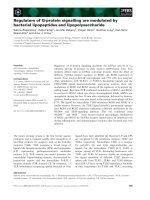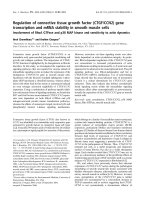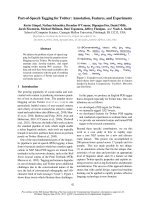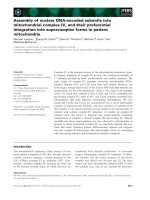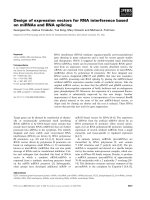Báo cáo khoa học: Design of expression vectors for RNA interference based on miRNAs and RNA splicing potx
Bạn đang xem bản rút gọn của tài liệu. Xem và tải ngay bản đầy đủ của tài liệu tại đây (800.92 KB, 7 trang )
Design of expression vectors for RNA interference based
on miRNAs and RNA splicing
Guangwei Du, Joshua Yonekubo, Yue Zeng, Mary Osisami and Michael A. Frohman
Department of Pharmacology and the Center for Developmental Genetics, Stony Brook University, NY, USA
Target genes can be silenced by transfection of chemic-
ally or enzymatically synthesized small interfering
RNAs (siRNA) or by DNA-based vector systems that
encode short hairpin RNAs (shRNAs) that are further
processed into siRNAs in the cytoplasm. The initially
designed and most widely used vector-based RNA
interferences (RNAi) are driven by RNA polymerase
III promoters, e.g., H1 and U6 [1,2]. Several recent
RNAi vectors driven by polymerase II promoters are
based on endogenous small RNAs ( 22 nucleotides)
known as microRNAs (miRNAs) that can also guide
cleavage of RNAs and ⁄ or translational inhibition. Cul-
len and colleagues first described this kind of RNAi
vector in which a synthetic siRNA ⁄ miRNA is
expressed from a synthetic stem-loop precursor based
on the miR30 miRNA precursor [3]. Subsequently,
other groups have developed additional miR30- or
miR155-based vectors for RNAi [4–6]. The expression
of siRNAs from the artificial miRNA driven by an
RNA polymerase II promoter offers several advan-
tages over an RNA polymerase III promoter, including
expression of several artificial miRNAs from a single
transcript, and tissue-specific or regulated expression
[4,6,7].
In animals, primary miRNAs (pri-miRNAs) are
transcribed by RNA polymerase II, and contain
5¢ CAP structures and 3¢ poly(A) tails [8,9]. The pri-
miRNA is recognized and cleaved at a specific hairpin
site by the nuclear microprocessor complex, which con-
tains an RNase III family enzyme, Drosha, to produce
a miRNA precursor (pre-miRNA) of approximately
70–90 nucleotides with a 2 nucleotide 3¢ overhang [10–
14]. This distinctive structure activates transport of the
pre-miRNA to the cytoplasm by Exportin-5 [8,9,15].
Keywords
intron; miRNA; RNA interference; RNA
splicing; small-hairpin RNA
Correspondence
G. Du, Department of Pharmacology and
the Center for Developmental Genetics,
Stony Brook University, Stony Brook,
NY 11794-5140, USA
Fax: +1 631 632 1692
Tel: +1 631 632 1477
E-mail:
(Received 13 July 2006, revised 9 Septem-
ber 2006, accepted 11 October 2006)
doi:10.1111/j.1742-4658.2006.05534.x
RNA interference (RNAi) mediates sequence-specific post-transcriptional
gene silencing in many eukaryotes and is used for reverse genetic studies
and therapeutics. RNAi is triggered by double-stranded small interfering
RNAs (siRNAs), which can be processed from small hairpin RNAs gener-
ated from an expression vector. In some recently described vectors, the
siRNAs are expressed from synthetic stem-loop precursors of microRNAs
(miRNAs) driven by polymerase II promoters. We have designed new
RNAi vectors, designated pSM155 and pSM30, that take into considera-
tion miRNA processing and RNA splicing by placing the miRNA-based
artificial miRNA expression cassettes inside of synthetic introns. Like the
original miRNA vectors, we show that the pSM155 and pSM30 constructs
efficiently down-regulate expression of firefly luciferase and an endogenous
gene, phospholipase D2. Moreover, the expression of a coexpressed fluores-
cent marker is substantially improved by this new design. Another
improvement of these new vectors is incorporation of two inverted BsmBI
sites placed internal to the arms of the new miRNA-based vectors, so
oligos used for cloning are shorter and the cost is reduced. These RNAi
vectors thus provide new tools for gene suppression.
Abbreviations
EGFP, enhanced green fluorescent protein; miRNA, microRNA; pre-miRNA, miRNA precursor; PLD2, phospholipase D2; pri-miRNAs, primary
miRNAs; RNAi, RNA interference; siRNAs, small interfering RNAs; shRNAs, small-hairpin RNAs.
FEBS Journal 273 (2006) 5421–5427 ª 2006 The Authors Journal compilation ª 2006 FEBS 5421
The pre-miRNA is then recognized by another RNase
III, Dicer, and cleaved to produce a mature miRNA
of 22 nucleotides. miRNAs can be categorized into
three groups according to their genomic context: exon-
ic miRNA in noncoding transcripts, intronic miRNAs
in noncoding transcripts, and intronic miRNAs in
protein-coding transcripts [8,9].
Based on the accumulating knowledge on miRNA
biogenesis, we report here the development of vectors
in which the artificial miRNAs are expressed from arti-
ficial introns. The artificial miRNAs expressed from
both miR30- and miR155-based miRNA precusors
using this strategy efficiently knockdown expression of
the luciferase reporter and an endogenous gene. More-
over, this vector also provides a robust marker for the
artificial miRNA-transfected cells.
Results and Discussion
Generation of miRNA-based RNAi vectors based
on RNA splicing
Recent strategies have described coupling fluorescent
protein expression directly to artificial miRNA expres-
sion in order to provide a way to identify transfected
cells genuinely expressing the artificial miRNA [4,6,7].
An example of this design is shown in Fig. 1A [4]. As
shown, the pri-miRNAs based on miR155 are proc-
essed in the nucleus by Drosha to set up transport of
pre-miRNAs to the cytoplasm, where they are further
processed to siRNA. However, this process simulta-
neously blocks the translation of the enhanced green
fluorescent protein (EGFP) marker, because the result-
ing mRNA fragment lacks a 5¢ CAP structure and is
rapidly degraded. EGFP can be translated if the pri-
miRNAs are exported to the cytoplasm before Drosha
cleavage; but siRNAs are then not produced from
these unprocessed pri-miRNAs. Similar issues apply to
the original miR30-based vectors (Fig. 1B) [6,7].
We hypothesized that both functions could be
accommodated if the pri-miRNAs were processed in
nuclei without inactivating the EGFP component. To
achieve this, we inserted the miR155 and miR30 artifi-
cial miRNA-expressing cassettes into a chimeric intron
composed of the 5¢ donor site from the first intron of
the human b-globin gene and the branch and 3¢ accep-
tor site from the intron of an immunoglobulin gene
heavy chain variable region (derived from pCI-neo
from Promega) (Fig. 1C,D). This design mimics the
structure and processing of some natural miRNAs
AC
DB
Fig. 1. Strategy for improved RNAi knockdown and ⁄ or marker gene expression. (A,B) In the original miRNA-based artificial miRNA expres-
sion vectors, pmiR155 (A) and pmiR30 (B), the artificial miRNA and EGFP segments are coexpressed as a combined exonic transcript. EGFP
would not be expected to be efficiently translated because the processing of the miRNA leads to a cleaved mRNA product that is not stable
and degrades quickly. (C,D) Placing the miRNA-based artificial miRNA expression cassette in a synthetic intron in pSM155 (pSpliced miR155)
and pSM30 (pSpliced miR30) might increase the production of siRNAs and the expression of EGFP, because the RNA precursors for both
can be processed better or stabilized in the nuclei.
Artificial miRNA from introns G. Du et al.
5422 FEBS Journal 273 (2006) 5421–5427 ª 2006 The Authors Journal compilation ª 2006 FEBS
which consist of intronic miRNAs in protein-coding
transcripts [8,9]. Separation by splicing of the miRNA
component from the 5¢ CAP-exon-EGFP-3 ¢ poly(A)
component should facilitate Drosha processing of
the pri-miRNA rather than cytoplasmic export, and
should favor cytoplasmic export and translation for
the EGFP component, rather than intranuclear degra-
dation. We denoted these modified miRNA-based
RNAi vectors, pSM155 (Spliced miR155, Fig. 1C) and
pSM30 (Spliced miR30, Fig. 1D).
To simplify the cloning of artificial miRNAs with-
out substantially altering the miRNA arm sequences,
inverted BsmBI sites were placed internal to the arms
of pSM30 and pSM155, as well as to those of
pmiR30 and pmiR155 (Fig. 2A,B). A pair of oligo-
nucleotide primers with appropriate 4 nucleotides
overhangs can be easily ligated to the cohesive sites
of the vector generated by BsmBI digestion. The
sequences and predicted precursor structures from the
oligonucleotide primer pairs used in this study are lis-
ted in Fig. 2C.
The pSM155 and pSM30 vectors generate
efficient knockdown of target proteins
To examine the efficiency of generation of RNAi for
pSM155 and pSM30, we examined the knockdown of
expression of firefly Luciferase (Luc). HeLa cells were
transfected with the parental and modified vectors con-
taining control and Luc targeting sequences and the
efficiency of down-regulation assessed (Fig. 3). Expres-
sion of Luc artificial miRNA from the modified vec-
tors SM155 and SM30 yielded consistently better
knockdown than the parental vectors pmiR155 and
pmiR30, although the degree of improvement was
modest. These findings imply that expression of
miRNA-based siRNAs from an intron may improve
RNAi to a small extent.
We then examined the down-regulation of an endo-
genous gene, phospholipase D2 (PLD2). PLD2 hydro-
lyzes phosphatidylcholine to generate choline and the
bioactive lipid phosphatidic acid, and has been impli-
cated in signal transduction, membrane trafficking,
transformation, and cytoskeletal reorganization [16,17].
HeLa cells were transfected with miRNA-based con-
structs expressing artificial miRNAs against PLD2.
Artificial miRNAs expressed from both pmiR155 and
pSM155 significantly down-regulated the expression of
endogenous PLD2, although in this case a signifi-
cant improvement of PLD2 knockdown by
pSM155 construct over pmiR155 was not observed
(Fig. 4).
Fig. 2. Improved strategy for inserting specific artificial miRNA
sequences into the targeting vectors. The terminal regions of the
arms of the miR155 (A) and miR30 (B) vectors are shaded, and
their stems designed to be replaced by artificial miRNA
sequences directed against genes of interest. Two inverted
BsmBI sites (underlined) were introduced as shown. Because the
cutting sites of BsmBI are outside of the recognition sites, BsmBI
digestion leaves the miRNA arms unchanged and generates two
different cohesive ends into which a synthetic DNA duplex can be
inserted to replace the original miR155 or miR30 sequences. The
cloning of luc-C artificial miRNA sequences (shown as grey font)
is shown as an example. The central black font indicates the loop
region. (C) Sequences and predicted precursor structures for
miRNA-based artificial miRNA used in this study. Artificial miRNA
expression is driven by a cytomegalovirus (CMV) promoter. The
stems of miR30 or miR155 were replaced with sequences that
were complementary to the firefly luciferase (luc) and phospho-
lipase D2 (PLD2) (shown as grey fonts).
G. Du et al. Artificial miRNA from introns
FEBS Journal 273 (2006) 5421–5427 ª 2006 The Authors Journal compilation ª 2006 FEBS 5423
Labeling of artificial miRNA-transfected cells
by EGFP is significantly improved by the use
of pSM155 and pSM30
It is necessary to be able to identify artificial miRNA-
transfected cells in some RNAi experiments, especially
when the transfection efficiency is low. In the RNA
polymerase III promoter-driven shRNA expression
vectors, fluorescent proteins (e.g., EGFP or dsRed, a
red fluorescent protein from Discosoma sp. reef coral)
are typically used as the marker and are expressed
from a separate RNA polymerase II promoter. Expres-
sion of the artificial miRNA and the marker from a
single RNA transcript in the miRNA-based expression
systems provides a more tightly linked marker that
directly indicates the level of expression of the artificial
miRNA. However, as discussed above, directly linking
the marker ORF to a miRNA-based artificial miRNA
expression cassette as shown in Fig. 1A may lead to
inefficient translation of the marker protein [6,7]. We
thus tested if the new pSM155 and pSM30 vectors
improve expression of the EGFP marker.
HeLa cells were cotransfected with artificial
miRNAs directed against firefly luciferase or PLD2 in
the pmiR155 or pSM155 vectors described above, and
pcDNA3.1-mCherry, which encodes a red fluorescent
protein, to identify transfected cells. EGFP expressed
poorly in the pmiR155 plasmids carrying the luciferase
and PLD2 artificial miRNAs. However, the expression
of EGFP was dramatically improved in the cells trans-
fected with the pSM155 constructs expressing the same
artificial miRNAs (Fig. 5A). To further confirm that
the pSM155 indeed increases expression of the marker
protein, expression of EGFP was also measured by
western blotting. HeLa cells were cotransfected with
the artificial miRNAs against firefly luciferase or
PLD2 in the pmiR155 or pSM155 vectors, and pRK-
human IgG, as a transfection and loading control.
EGFP expressed poorly in the cells transfected with
the pmiR155 constructs, but at very high levels in the
cells transfected with pSM155 constructs (Fig. 5B). We
also compared the expression of EGFP when the
EGFP ORF is directly linked to the miR30 artificial
miRNA expression cassette (pmiR30) or to the same
cassette located inside the synthetic intron (pSM30,
Fig. 1C,D). Again, the expression of EGFP was signifi-
cantly improved for the pSM30 artificial miRNA tar-
geting vectors, as measured by fluorescent microscopy
(Fig. 5C) and western blotting (Fig. 5D). These results
demonstrate that introducing the splicing sequences for
the miRNA expression cassette is a successful general
strategy for improving marker gene protein expression.
In this study, insertion of the miRNA-based
artificial miRNA expression cassette into an intron
AB
Fig. 3. Efficient knockdown of luciferase expression by an intronic miRNA approach. HeLa cells were transfected with artificial miRNAs
directed against firefly luciferase in pmiR155 or pSM155 (A), or pmiR30 or pSM30 (B). Renilla luciferase plasmid served as the transfection
control. The luciferase activities were normalized to the value measured in lysates from cells transfected with control empty vectors. The
values presented are means with standard deviation (n ¼ 3).
Fig. 4. Knockdown of endogenous PLD2 using pmiR155 and
pSM155. HeLa cells were transfected with artificial miRNAs against
luciferase (control) and PLD2 in pmiR155 and pSM155. Cell lysates
were collected for western blotting two days after transfection.
PLD2 and a-tubulin were detected by a polyclonal antibody and a
mouse monoclonal antibody, respectively, followed by goat anti-
rabbit secondary IgG conjugated to Alexa 680 and goat anti-mouse
conjugated to IRDye 800. Fluorescence was quantitated using an
Odyssey infrared imaging system from LI-COR Bioscience-Biotech-
nology (Lincoln, NE, USA).
Artificial miRNA from introns G. Du et al.
5424 FEBS Journal 273 (2006) 5421–5427 ª 2006 The Authors Journal compilation ª 2006 FEBS
significantly increased expression of the marker pro-
tein. Insertion of a miRNA-based artificial miRNA
expression cassette into an intron was recently reported
by two other groups [4,18]. In both cases, the miR155
and miR30 cassettes were placed into the first intron
of the human ubiquitin C gene [4,18]. However, the
efficiencies of RNAi and marker gene expression were
not compared between the original and modified vec-
tors. Our results demonstrate that the incorporation of
an intronic strategy offers a modest at best improve-
ment in the efficiency of RNAi, but generates a
dramatic improvement in marker gene expression.
This result suggests that Drosha processing of the pri-
miRNA is relatively efficient even when the miRNA
cassette is in an exon, but correspondingly that most
of the marker protein expression is lost through degra-
dation of the resulting unstable mRNA that lacks a 5¢
CAP structure (Fig. 1A). The success of these vectors
using a synthetic intron also indicates that the con-
served sequences for mRNA splicing (5¢ donor,
branch, and 3¢ acceptor sites) suffice for the efficient
processing of pri-miRNAs.
In previous studies, the ORFs for marker proteins
were placed at the 5¢ end of the miRNA expression
cassette and were reported to express at reasonable
levels. In the current study, in which we placed the
ORF for marker proteins at the 3¢ end of the miRNA
expression cassette in the ‘classical’ miRNA vectors
(pmiR155 and pmiR30), the EGFP was expressed
poorly, as judged by both fluorescent microscopy and
western blotting. Two possibilities may account for
this discrepancy: First, placing the marker protein
ORFs at the 5¢ end might have interfered with the pri-
miRNA processing, causing more unprocessed pri-
miRNA to be transported into the cytoplasm. If this is
the case, then the production of miRNAs should have
been less effective. Second, placing the miRNA 5¢ to
the marker protein ORF in the pmiR155 and pmiR30
vectors as we describe here may have resulted in the
presence of RNA secondary structures that decreased
translation efficiency for the downstream ORF in
unprocessed pri-miRNAs. However, expression of the
marker (regardless of the placement location) could
only occur at the expense of failure of cleavage of pri-
miRNA by Drosha [8,9]. In contrast and in summary,
the RNAi expression vectors we describe here,
pSM155 and pSM30, which are designed based on
knowledge of miRNA and RNA splicing, provide a
AB
DC
Fig. 5. The new pSM155 and pSM30 vectors improve the expression of marker proteins in artificial miRNA-expressing cells. All miR155 and
miR30 constructs contain an EGFP marker as illustrated in Fig. 1. (A) HeLa cells were cotransfected with pmiR155-lucC, pmiR155-PLD2,
pSM155-lucC, or pSM155-PLD2, and pcDNA3.1 ⁄ mCherry, which encodes a red fluorescent protein and is used to identify transfected cells.
Expression of the EGFP marker protein is significantly improved in pSM155 for both constructs tested: whereas EGFP is expressed in all
cells expressing mCherry when the pSM155 vector is used, it is only expressed in a few of the cells when pmiR155 is used. (B) HeLa cells
were cotransfected with pmiR155-lucC (lane 1), pSM155-lucC (lane 2), pmiR155-PLD2 (lane 3), or pSM155-PLD2 (lane 4), and pRK-human
IgG, which encodes a human IgG and was used as a transfection and loading control. The expression of EGFP and IgG on the western blot
was determined by the rabbit polyclonal GFP antibody ⁄ Alexa 680 goat anti-rabbit secondary IgG, and IRDye 800 goat anti-human IgG,
respectively. (C) HeLa cells were cotransfected with pmiR30-luc549, pmiR30-PLD2, pSM30-luc549, or pSM30-PLD2, and pcDNA3.1 ⁄
mCherry, and were analyzed as in (A). (D) HeLa cells were cotransfected with pmiR30-luc549 (lane 1), pSM30-luc549 (lane 2), pmiR30-PLD2
(lane 3), or pSM30-PLD2 (lane 4), and pRK-human IgG, and were analyzed as in (B).
G. Du et al. Artificial miRNA from introns
FEBS Journal 273 (2006) 5421–5427 ª 2006 The Authors Journal compilation ª 2006 FEBS 5425
better approach to achieve efficient expression of both
the RNAi cassette and the marker gene for transiently
transfected cell experiments.
Experimental procedures
General reagents and antibodies
Cell culture media, Dulbecco’s Modified Eagle Medium
(DMEM), Opti-MEM-I, and LipofectAMINE Plus were
from Invitrogen (Carlsbad, CA, USA). All other reagents
were of analytical grade unless otherwise specified.
The rabbit polyclonal anti-PLD2 was kindly provided by
Y. Banno (Gifu University of Tokyo, Gifu, Japan). Rabbit
anti-green fluorescent protein (GFP) was from Abcam
(Cambridge, MA, USA). Monoclonal anti-(a-tubulin) was
from Sigma-Aldrich (St Louis, MO, USA). Goat anti-
mouse and anti-rabbit IgG conjugated to Alexa 680 were
from Invitrogen. Goat anti-mouse and anti-human IgG
conjugated to IRDye 800 were from Rockland Immuno-
chemicals (Gilbertsville, PA, USA).
Plasmid construction
pcDNA3.1-mCherry was constructed by removing mCherry
from pRSET-B-mCherry [19] (provided by R Y Tsien) with
BamHI and HindIII, and ligating it into pcDNA3.1 ⁄ Zeo(–)
(Invitrogen) cut with these same enzymes.
The pmiR30 vector without GFP was constructed by clo-
ning the miR30 arms from the pSM2 (cut by SalI and
MfeI) (provided by G Hannon) into the XhoI and EcoRI
sites of pcDNA3.1 ⁄ myc-His(–)A (all sites were destroyed),
and subsequently inserting a pair of oligos, 5¢-tcgagaa
ggtatattgctgttgacagtgagcgagag acggaagccacagacgtctcatg cctac
tgcctcgg-3¢ and 5¢-aattccgaggcagtaggcatgagacgtctgtggcttccgt
ctctcgctcactgtcaacagcaatataccttc-3¢ into the XhoI and EcoRI
sites of the resulting plasmid. The pmiR30 used in this
study (containing an EGFP ORF) was generated by sub-
cloning the miR30 cassette into the NheI and Acc65I sites
of pEGFP-N1. pmiR155 was generated by insertion of a
pair of oligos, 5¢-tcgacttctagagctctggaggcttgctgaaggctgtatgc
tagagacgtacagatgcgtctcacaggacacaaggcc tgttactagcactcac atgg
aacaaatggccg-3¢, and 5¢-aattcggccatttgttccatgtgagtgctagtaaca
ggccttgtgtcctgtgagacg catctgtacgtctctagcatacagccttcagcaagcct
ccagagctctagaag-3¢, into the XhoI and EcoRI sites of pEG-
FP-N1. Two inverted BsmBI sites were introduced to facili-
tate subsequent insertion of artificial miRNAs.
Two steps of cloning were used to construct vectors
expressing miR30- and miR155-based artificial miRNAs,
pSM30 and pSM155. Part of the cytomegalovirus (CMV)
promoter and a synthetic exon and intron were amplified
from pCI-Neo (Promega, Madison, WI, USA) by PCR
using primers 5¢-gtacatcaagtgtatcatatgcc-3¢ and 5¢-gtctgaatt
catcgtccgtcgaccgaaacgcaagagtcttctctgtc-3¢, and then cut by
NdeI and EcoRI. The digested PCR product was then
ligated to a pair of oligos containing several restriction
sites, 5¢-aattcggcgctagctgctgatatcgcatacgcgtggaccagataggcacct
attggtcttactgacatccactttgcctttctctccacaggtgtcg-3¢ and 5¢-gtac
cgacacctgtggagagaaaggcaaagtggatgtcagtaagaccaataggtgcctat
ctggtccacgcgtatgcgatatcagcagctagcgccg-3¢, and pEGFP-N1
cut by NdeI and Acc65I, to generate pEGFP-N1-Intron.
pSM30 and pSM155 were then generated by subcloning
the miR30 expression cassette from pmiR30, and the pair
of oligos used to generate pmiR155, into the XhoI and
EcoRI sites of pEGFP-N1-Intron, respectively. A pair of
oligos including cohesive ends and a specific sequence for
each artificial miRNA (64 nucleotides for the miR155-
based system and 67 nucleotides for the miR30-based sys-
tem) were annealed, and cloned into the corresponding ends
created by BsmBI digestion in the vectors (Fig. 2A,B). The
selection of target sequences and design of artificial miRNA
stem-loops were based on the algorithms accessible at
(for miR155 system), http://
codex.cshl.edu (for miR30 system), and the published guide-
lines for selecting highly effective siRNA sequences [20]. The
oilgos for candidate sequences also contained cohesive ends
for our simplified cloning strategy. The artificial miRNA
sequences and predicted precursor structures used in this
study are summarized in Fig. 2C.
Cell culture and transfection
HeLa cells were maintained in DMEM supplemented
with 10% (v ⁄ v) calf serum, 100 UÆmL
)1
penicillin, and
100 lgÆmL
)1
streptomycin. For transfections, cells were
grown in 6-well or 12-well plates and then switched into
Opti-MEM I media before being transfected with 1 lgor
0.5 lg of DNA per well using LipofectAMINE Plus. Four
hours post transfection, the media was replaced with fresh
growth medium and the cells incubated for an additional
24–48 h.
Luciferase assay
HeLa cells were plated in 12-well plates one day prior to
transfection. The cells were transfected with a plasmid
encoding firefly luciferase driven by a CMV promoter
(0.4 lg), pRL-TK DNA (0.1 lg), which encodes Renilla
luciferase, and artificial miRNAs or vector control. Cells
were harvested 48 h after transfection and luciferase activity
measured using the Dual-Luciferase Reporter Assay System
from Promega (Madison, WI, USA). Luciferase activity
was defined as the ratio of firefly luciferase activity to
Renilla luciferase activity. The relative luciferase activity
was then normalized to the relative activity observed with
transfection of control empty vectors expressing the
miRNA arms but not artificial miRNAs.
Artificial miRNA from introns G. Du et al.
5426 FEBS Journal 273 (2006) 5421–5427 ª 2006 The Authors Journal compilation ª 2006 FEBS
Western blotting
Twenty micrograms of total cell lysates were separated
using 8% (w ⁄ v) SDS ⁄ PAGE, transferred to nitrocellulose
membrane, probed overnight with primary antibodies,
washed, and incubated with secondary antibody conjugated
to Alexa 680 or IRDye 800. Fluorescent signals were detec-
ted with an Odyssey infrared imaging system from LI-COR
Biosciences – Biotechnology (Lincoln, NE, USA).
Acknowledgements
The authors thank Dr Yoshiko Banno for the PLD2
antibody, Dr Greg Hannon for the pSM2 vector, Dr
Roger Y. Tsien for the pRSET-B-mCherry, and Dr
Jen-Chih Hsieh for the pRK-human IgG construct.
We also thank Dr Jian Cao for allowing us to use his
fluorescent microscope. This work was supported by a
Scientist Development Grant from the American Heart
Association to GD (0430096 N) and research grants
from National Institutes of Health to GD
(GM071475) and MAF (DK64166 and GM71520).
References
1 Brummelkamp TR, Bernards R & Agami R (2002) A
system for stable expression of short interfering RNAs
in mammalian cells. Science 296, 550–553.
2 Paddison PJ, Caudy AA, Bernstein E, Hannon GJ &
Conklin DS (2002) Short hairpin RNAs (shRNAs)
induce sequence-specific silencing in mammalian cells.
Genes Dev 16, 948–958.
3 Zeng Y, Wagner EJ & Cullen BR (2002) Both natural
and designed micro RNAs can inhibit the expression of
cognate mRNAs when expressed in human cells. Mol
Cell 9, 1327–1333.
4 Chung KH, Hart CC, Al-Bassam S, Avery A, Taylor J,
Patel PD, Vojtek AB & Turner DL (2006) Polycistronic
RNA polymerase II expression vectors for RNA inter-
ference based on BIC ⁄ miR-155. Nucleic Acids Res 34,
doi: 10.1093/nar/gkl143.
5 Silva JM, Li MZ, Chang K, Ge W, Golding MC,
Rickles RJ, Siolas D, Hu G, Paddison PJ, Schlabach
MR et al. (2005) Second-generation shRNA libraries
covering the mouse and human genomes. Nat Genet 37,
1281–1288.
6 Stegmeier F, Hu G, Rickles RJ, Hannon GJ & Elledge
SJ (2005) A lentiviral microRNA-based system for
single-copy polymerase II-regulated RNA interference
in mammalian cells. Proc Natl Acad Sci USA 102,
13212–13217.
7 Dickins RA, Hemann MT, Zilfou JT, Simpson DR,
Ibarra I, Hannon GJ & Lowe SW (2005) Probing tumor
phenotypes using stable and regulated synthetic micro-
RNA precursors. Nat Genet 37, 1289–1295.
8 Cullen BR (2004) Transcription and processing of
human microRNA precursors. Mol Cell 16, 861–865.
9 Kim VN (2005) MicroRNA biogenesis: coordinated
cropping and dicing. Nat Rev Mol Cell Biol 6, 376–
385.
10 Denli AM, Tops BB, Plasterk RH, Ketting RF &
Hannon GJ (2004) Processing of primary microRNAs
by the Microprocessor complex. Nature 432, 231–235.
11 Han J, Lee Y, Yeom KH, Kim YK, Jin H & Kim VN
(2004) The Drosha-DGCR8 complex in primary micro-
RNA processing. Genes Dev 18, 3016–3027.
12 Lee Y, Ahn C, Han J, Choi H, Kim J, Yim J, Lee J,
Provost P, Radmark O, Kim S et al. (2003) The nuclear
RNase III Drosha initiates microRNA processing.
Nature 425, 415–419.
13 Zeng Y, Yi R & Cullen BR (2005) Recognition and
cleavage of primary microRNA precursors by the
nuclear processing enzyme Drosha. Embo J 24,
138–148.
14 Gregory RI, Yan KP, Amuthan G, Chendrimada T,
Doratotaj B, Cooch N & Shiekhattar R (2004) The
Microprocessor complex mediates the genesis of micro-
RNAs. Nature 432, 235–240.
15 Lund E, Guttinger S, Calado A, Dahlberg JE & Kutay
U (2004) Nuclear export of microRNA precursors.
Science 303, 95–98.
16 Du G, Huang P, Liang BT & Frohman MA (2004)
Phospholipase D2 localizes to the plasma membrane
and regulates angiotensin II receptor endocytosis. Mol
Biol Cell 15, 1024–1030.
17 Frohman MA, Sung T-C & Morris AJ (1999) Phospho-
lipase D Structure and Regulation. Biochem Biophys
Acta
1439, 175–186.
18 Zhou H, Xia XG & Xu Z (2005) An RNA polymerase
II construct synthesizes short-hairpin RNA with a quan-
titative indicator and mediates highly efficient RNAi.
Nucleic Acids Res 33, doi: 10.1093/nar/gni061.
19 Shaner NC, Campbell RE, Steinbach PA, Giepmans BN,
Palmer AE & Tsien RY (2004) Improved monomeric
red, orange and yellow fluorescent proteins derived from
Discosoma sp. red fluorescent protein. Nat Biotechnol 22,
1567–1572.
20 Ui-Tei K, Naito Y, Takahashi F, Haraguchi T, Ohki-
Hamazaki H, Juni A, Ueda R & Saigo K (2004) Guide-
lines for the selection of highly effective siRNA
sequences for mammalian and chick RNA interference.
Nucleic Acids Res 32, 936–948.
G. Du et al. Artificial miRNA from introns
FEBS Journal 273 (2006) 5421–5427 ª 2006 The Authors Journal compilation ª 2006 FEBS 5427


